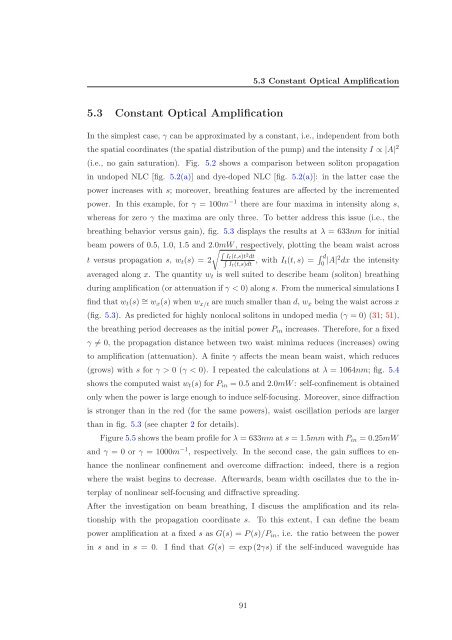Solitons in Nonlocal Media
Solitons in Nonlocal Media
Solitons in Nonlocal Media
You also want an ePaper? Increase the reach of your titles
YUMPU automatically turns print PDFs into web optimized ePapers that Google loves.
5.3 Constant Optical Amplification<br />
5.3 Constant Optical Amplification<br />
In the simplest case, γ can be approximated by a constant, i.e., <strong>in</strong>dependent from both<br />
the spatial coord<strong>in</strong>ates (the spatial distribution of the pump) and the <strong>in</strong>tensity I ∝ |A| 2<br />
(i.e., no ga<strong>in</strong> saturation). Fig. 5.2 shows a comparison between soliton propagation<br />
<strong>in</strong> undoped NLC [fig. 5.2(a)] and dye-doped NLC [fig. 5.2(a)]: <strong>in</strong> the latter case the<br />
power <strong>in</strong>creases with s; moreover, breath<strong>in</strong>g features are affected by the <strong>in</strong>cremented<br />
power. In this example, for γ = 100m −1 there are four maxima <strong>in</strong> <strong>in</strong>tensity along s,<br />
whereas for zero γ the maxima are only three. To better address this issue (i.e., the<br />
breath<strong>in</strong>g behavior versus ga<strong>in</strong>), fig. 5.3 displays the results at λ = 633nm for <strong>in</strong>itial<br />
beam powers of 0.5, 1.0, 1.5 and 2.0mW, respectively, plott<strong>in</strong>g the beam waist across<br />
t versus propagation s, wt(s) = 2<br />
It(t,s)t 2 dt<br />
It(t,s)dt , with It(t, s) = d<br />
0 |A|2 dx the <strong>in</strong>tensity<br />
averaged along x. The quantity wt is well suited to describe beam (soliton) breath<strong>in</strong>g<br />
dur<strong>in</strong>g amplification (or attenuation if γ < 0) along s. From the numerical simulations I<br />
f<strong>in</strong>d that wt(s) ∼ = wx(s) when w x/t are much smaller than d, wx be<strong>in</strong>g the waist across x<br />
(fig. 5.3). As predicted for highly nonlocal solitons <strong>in</strong> undoped media (γ = 0) (31; 51),<br />
the breath<strong>in</strong>g period decreases as the <strong>in</strong>itial power P<strong>in</strong> <strong>in</strong>creases. Therefore, for a fixed<br />
γ = 0, the propagation distance between two waist m<strong>in</strong>ima reduces (<strong>in</strong>creases) ow<strong>in</strong>g<br />
to amplification (attenuation). A f<strong>in</strong>ite γ affects the mean beam waist, which reduces<br />
(grows) with s for γ > 0 (γ < 0). I repeated the calculations at λ = 1064nm; fig. 5.4<br />
shows the computed waist wt(s) for P<strong>in</strong> = 0.5 and 2.0mW: self-conf<strong>in</strong>ement is obta<strong>in</strong>ed<br />
only when the power is large enough to <strong>in</strong>duce self-focus<strong>in</strong>g. Moreover, s<strong>in</strong>ce diffraction<br />
is stronger than <strong>in</strong> the red (for the same powers), waist oscillation periods are larger<br />
than <strong>in</strong> fig. 5.3 (see chapter 2 for details).<br />
Figure 5.5 shows the beam profile for λ = 633nm at s = 1.5mm with P<strong>in</strong> = 0.25mW<br />
and γ = 0 or γ = 1000m −1 , respectively. In the second case, the ga<strong>in</strong> suffices to en-<br />
hance the nonl<strong>in</strong>ear conf<strong>in</strong>ement and overcome diffraction: <strong>in</strong>deed, there is a region<br />
where the waist beg<strong>in</strong>s to decrease. Afterwards, beam width oscillates due to the <strong>in</strong>-<br />
terplay of nonl<strong>in</strong>ear self-focus<strong>in</strong>g and diffractive spread<strong>in</strong>g.<br />
After the <strong>in</strong>vestigation on beam breath<strong>in</strong>g, I discuss the amplification and its rela-<br />
tionship with the propagation coord<strong>in</strong>ate s. To this extent, I can def<strong>in</strong>e the beam<br />
power amplification at a fixed s as G(s) = P(s)/P<strong>in</strong>, i.e. the ratio between the power<br />
<strong>in</strong> s and <strong>in</strong> s = 0. I f<strong>in</strong>d that G(s) = exp(2γs) if the self-<strong>in</strong>duced waveguide has<br />
91
















